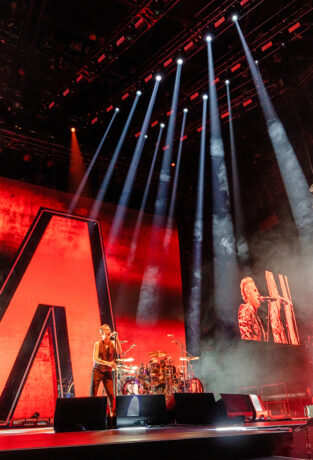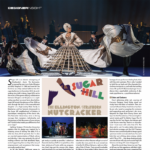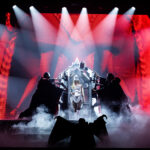
For the first time in five years, Depeche Mode is back out on tour supporting its most recent album—Memento Mori. The Live Nation-presented tour—also named Memento Mori—began March 23 with a limited North American run. Having been on the cutting-edge of music for decades pushing boundaries of the synth pop genre, it is no surprise that this, the 19th tour for Depeche Mode, is proving to be so popular that they’re adding more North America dates for the fall after the European leg. The band is now slated to play 80 dates for this tour. Lighting Designer Jason Baeri spoke with PLSN about his dynamic designs and how they support Depeche Mode’s music and audience experience on this tour.
Creative Vision
The Memento Mori Tour is the first Depeche project that Baeri has worked on, but he had the benefit of working with Photographer Anton Corbijn, the creative director with the band for well over 30 years. Corbijn provided Baeri with sketches of his ideas and concepts. “I was the lighting designer for the tour and also helped with the production design,” explains Baeri. “Anton is the creative director for the group, so the films that he makes for the band coincide with the image he has for the overall stage design of the plan, and then we helped him make that a reality. It started as a sketch from him and together we turned that into the show.”
Centerpiece to the stage design is a 27’-tall ‘M’-shaped backdrop, a large structural piece that runs video. It’s designed to be a scenic piece rather than just a video screen, so it has depth and weight to it. “The whole concept started with this large structural M that Anton came up with,” describes Baeri. “We were trying to support that shape and that structure with everything else. I always feel that with a video screen, it has to exist as an object. I know some people differ in that they feel like video screens should disappear or the edges don’t matter. To me it’s a very literal object. If it’s a big M-shaped screen and a big square behind it, then we need to embrace that as the overall structure of what we’re doing and play within that world.”
Baeri’s overhead lighting rig mimics the M structure. “It was a kind of forced perspective, reverse version of that M structure,” he says. “At the peak of the M when you’re looking at it from the front, it comes to a peak at the top, and then the lighting rig does the opposite of that fanning out from the top, from upstage to downstage. Then around the main screen itself, we tried to support that by embracing that big square structure of what a screen is by trying to outline it; make sure that when we had content up there that we had a frame for it, so to speak. So, the M was framed by itself, and the screen was framed by us.”
Baeri continues, “Anton had these very specific, literal looks; this very literal content. There is a lot of I-Mag, that is cut brilliantly, and then they switch to these almost music video like pieces that Anton does that take you away from the fact that you’re in liminal space and bring you back to a very reality-based space. That’s a really cool thing to be able to work with. It’s not something we get to do a lot where we’re actually watching films with the music.”
Much of the creative comes from Corbijn, although the band has input on the design as well. Baeri notes, saying “The band mostly does the initial creative rounds with Anton, and they had feedback from me as well, but they approved the films, and they approved the look of the show. We sent them plenty of lighting treatments and renders ahead of time that they approved and told us which parts they liked and which they didn’t. They’re a very relaxed group of guys and they’re very direct about the look that they’re going for. They were very helpful in supplying that information for us.” Along with that exchange of ideas, Baeri spent a lot of time getting to understand the band and creating a variety of different looks over the course of the show.
“There’s a couple different things that you think of when you think of Depeche Mode,” comments Baeri, “so you have to embrace both their rock ‘n’ roll side and their synth wave side and make both of those count. We tried to pick one language in each song depending on how that song really felt to us. We were sometimes trying to go either for big, beamy rock looks, and we were trying to go with things that were statement pieces made of the [Robe] MegaPointes, or we other times were going the other way and trying to use the [GLP] JDC1 strobe hits as a more digital element that existed throughout space. Those two fixtures were dotted throughout the rig. We had this really tight form of a linear lighting beam with the MegaPointes and then the JDC1 strobes had that definition-less wash feeling that just throws color everywhere. Those were the two things that we were really trying to balance within the show.”

Specific Choices
Baeri’s key gear choices for this tour supported the versatility he needed to be able to get with his design. “As I mentioned, the MegaPointe was definitely one of the feature fixtures of the show,” states the designer. “It’s a good toolkit fixture; a very rock and roll fixture. It’s something that lends itself to being a huge sculptural light. I don’t necessarily love the current wave of everything as a hybrid that is now taken over most of the fixtures. The MegaPointe is a spot fixture and it’s very specifically a spot fixture with spot features and it caters to its own hard-edge and the hard-edge feature set inside of it. For me, that’s a great choice for this show because it speaks one language on its own and you don’t really need to worry about getting half of a good set out of it.”
For his ground package, Baeri used a range of Elation Professional luminaires including the company’s Artiste Monet, Artiste Mondrian, and Artiste Rembrandt lights. “The Rembrandt is something where ‘everything old is new again,” but most wash fixtures on the market these days are really just a PC lens with a couple of optional frosts inside. The Rembrandt is an actual wash fixture that has a soft beam of light that wraps and not just a hard edge that has a little bit of softness to it or less defined quality. It’s a really great floor light fixture and it’s a really great soft edge wash fixture that we had a lot of fun with. Then the Monets provided a key light for us, which is just a nice clean, beautiful beam of light. And then on top of that we had Mondrians upstage, which is just a really awesome accent light. They have that big fat lens on the front of them. They just spit this huge, real sexy backlight out of them that you don’t really get out of a lot of fixtures these days.”
The frame of the video screen is outlined by Ayrton MagicBlade FX units, “which is something that looks almost like a marquee fixture,” says Baeri. “You can create those really thin lines of framing, which is something that was important to speak to the same language as the screen rather than just dots everywhere. And then of course, the GLP JDC1 strobe, which we had overhead—and on the floor, which really helped us with the songs where we needed to step away from beam definitions and go to more color blocks.”

Remote Followspotting
Like many designers these days, Baeri has made the transition to using remote controlled followspots for his designs. For Depeche Mode, he’s using six of the Robe RoboSpots. He has found that remote followspots are changing the way he uses followspots “for the better.” He further explains, “I hate the way followspots traditionally look. I hate that you have this beautiful, sculpted scene on stage and then you just throw this white circle on top of all of it. I think the ability to dynamically, not only change how that edge reads and where it can go in space, but also the ability to drive those spots into color that fits the song rather than the limited six cassette choices that you had in a traditional followspot, is a good thing. I think it’s most definitely the way to go from here on out; to have a fixture that has as many choices as you make with the rest of your lighting rig.”
4Wall Entertainment is the lighting vendor for the Memento Mori tour, with 4Wall’s Jordan Hanson out of the UK as the Account Manager for the tour. “4Wall has been fantastic,” states Baeri. “They supplied not only some great gear, but a really great team of people to take it out. Jake Jevons is the Lighting Crew Chief on it, and he and his whole team are a really fantastic crew. This is a rig that has a lot of little moving parts, and they handle it extremely well. Sarah Parker is the lighting director for the show and Joe Bay helped me program it and acted as the Associate Lighting Designer for it. I had a great team supporting me. I can’t say enough about them. Joe is every bit a part of the design as I am. The show looks the way it does in large part because of the work that he contributed to it; I’m really thankful to have him on my team. And Sarah, who takes this gigantic mess of fixtures and turns it into some beautifully crafted thing every single day. I mean, she’s a super big asset to the team.”
Baeri feels that the design really works for Depeche Mode’s tour and is happy with how it came out in the end. “I am glad that the way that we are supporting, and structurally embracing, the actual shape of the stage is something that we really tried to strive for and were able to achieve. Also, not being locked into one particular look for the show is something that we are really proud of and how we got those different looks out of the rig. But, with all that being said, it is a really classic-feeling rock ‘n’ roll type show. That was the backstory that we were trying to stick with the whole time. It definitely feels like something that when you see it, you are definitely like, ‘yeah, this is a rock show’ and not very poppy, not very overly bright, or overly keyed the entire time. We were allowed to be a little bit more dramatic because it was a little more in that world.”
For Baeri, the music of Depeche Mode takes him back to his youth, and he enjoys their whole catalog. “What I like about them is that their songs span such a range of different types and different structures that you don’t really have to sit there and say ‘oh, it’s this one sound of Depeche Mode.’ It really feels like from song to song you can be in a big heavy, a ‘Personal Jesus’ type rock song and it’s all about guitars and drums. And then you can switch over to ‘Policy of Truth’ and have something that’s a very electronic sounding that vibrates with you a little bit more than the traditional hitting you with a hard rock song. It’s also music that I grew up with. So, it’s really nice to be able to listen to those tracks and relive my high school days a little bit.”
With the very positive audience response to Depeche Mode being back on the road performing their fantastic catalog of music from the past four decades, it is obvious that the entire team hit the right notes with the design. No matter when you first encountered Depeche Mode, their music is a big part of many people’s soundtracks of their lives. The design of the Memento Mori certainly effectively supports the band; its music and also embraces the feelings it evokes for all of its fans.

Creating a Sparkling Line
Seeking to emulate the lighting that frames the video wall, Depeche Mode LD Jason Baeri says they sought a fixture to line the downstage edge and found what they were looking for in Elation’s new Proteus Rayzor Blade. “The Rayzor Blade is a nice take on the bar light and fits that role really well,” he stated. “It’s a really high-output fixture with clean color mixing and a zoom that has a great range. They definitely help to ground the downstage edge of the picture.”
Two high-intensity strobe lines of cool white LED dots run along the length of the Rayzor Blade unit, which also includes Elation’s proprietary SparkLED™ twinkle effect. “The strobe line is great,” Baeri comments. “It’s like a big slap in the face! Even when there’s a lot of brightness in the room it cuts through well.” The designer incorporates the SparkLED effect in a couple of songs. “It helps diffuse the nature of the unit being such a technical object. It’s a fun effect and even more useful for TV and camera work.” Baeri shares that the original plan was for the Rayzor Blades to also line the runway, but that idea had to be scrapped due to sightline issues.
Production Team
- Creative Director: Anton Corbijn
- Production and Lighting Designer: Jason Baeri
- Associate Lighting Designer: Joe Bay
- Lighting Director: Sarah Parker
- Video Director: John Shrimpton
- Lighting Crew Chief: Jake Jevons
- Dimmer Technician: Stuart Picton
- Lighting Technicians: Dom Crookes, Ben Eastham, Enrique Rodriguez, Devon Zuckerman
- Lighting Vendor: 4Wall
- 4Wall Account Manager: Jordan Hanson
- 4Wall Project Manager: Andy Whittaker
Gear
- 2 MA Lighting grandMA3 (2 Mode) full-size Console
- 1 MA Lighting grandMA3 light Console
- 6 MA Lighting grandMA3 NPUL
- 2 Martin P3-200 System Controller
- 4 Martin P3 PowerPort 1500
- 114 Robe MegaPointe
- 106 GLP JDC1 Hybrid Strobe
- 62 Ayrton MagicBlade FX
- 10 Elation Proteus Rayzor Blade L
- 6 Elation Artiste Rembrandt
- 5 Elation Artiste Monet
- 6 Elation Artiste Mondrian
- 6 Robe BMFL Spot (RoboSpot)
- 88 Martin Sceptron 10 1,000mm
- 58 Martin Sceptron 10 320mm
- 2 ETC Source Four LED Series 2 Lustr
- 6 Ultratec Radiance Hazer
- 2 5’ Tyler GT+ Truss
- 38 10’ Tyler GT+ Truss
- 260’ Standard Truss
- 12 2-Ton Hoist
- 42 1-Ton Hoist
- 2 ½-Ton Hoist


